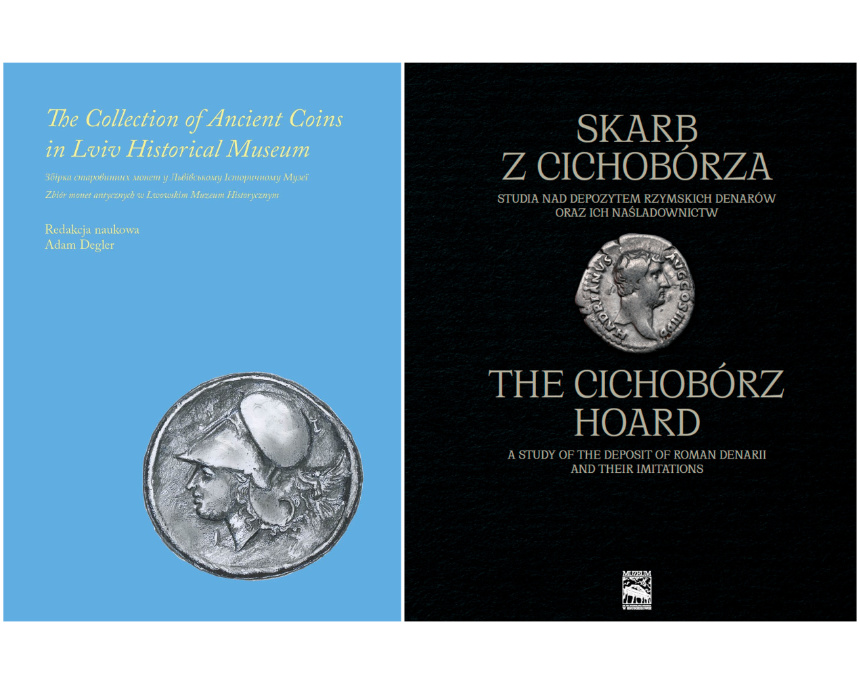Two New Books on Ancient Numismatics in Poland
by Adam Degler and Kyrylo Myzgin
Book news from Poland: In December 2023 and February, two significant books on Roman numismatics were published with an English translation. Adam Degler and Kyrylo Myzgin tell us more about their works.
Content
The Collection of Ancient Coins in Lviv Historical Museum
The first book is The Collection of Ancient Coins in Lviv Historical Museum (ed. Adam Degler; Wrocław / Lwów / Paryż: Yellow Point Publication, 2023, 442 pp.). This trilingual book (English, Polish and Ukrainian introduction and English catalogue entries) results from many years of study of the Lviv Historical Museum’s collection by a group of Polish and Ukrainian researchers. The Catalogue describes 2293 silver, billon, bronze and copper coins, which cover the products of Greek, Celtic, Roman (including the Republican period, imperial coins and Roman provincial and autonomous issues) and Byzantine mints. The provenance of the collection is diverse. The most numerous part, described in Chapter I, are coins from various former L’viv collections. The former collection of the Taras Shevchenko Scientific Society is described in Chapter II; some of the coins there can be linked to single or collective finds known from numismatic literature. We can see some beautiful examples of Greek coins in those first two chapters. The most numerous single denomination is denarius. The vast majority of denarii come from hoards found in Ukraine and Poland. From Ukraine come the part of the famous hoard from Borochyche in the Volyn region, a hoard from Luchytsi in the Lviv region (Chapter III), from Oliyiv in the Ternopil region (Chapter IV), from Zbuzh in the Rivne region (Chapter VI). From Poland come the hoard from Przędzel, podkarpackie voivodship (Chapter V). The book also includes the products of barbarian imitations of denarii, of which three specimens cannot be attributed to any find, three more come from the hoard from Luchytsi and two more come from the hoard from Zbuzh. One can find also counterfeits from the Modern period, including copies of Renaissance fantasy medal.

Adam Degler (ed.), The Collection of Ancient Coins in Lviv Historical Museum. Yellow Point Publication, 2023. 442 pp. English – Polish – Ukrainian. Hardcover, 220 x 280 mm. ISBN 978-83-950094-5-7. Price: 67,00 EUR.
The Cichobórz Hoard: A Study of the Deposit of Roman Denarii and Their Imitations
Another book is a collective monograph devoted to studying one of Poland’s largest hoards of Roman denarii discovered over the last half century – the Cichobórz Hoard: A Study of the Deposit of Roman Denarii and Their Imitations (eds. Bartłomiej Bartecki, Anna Hyrchała, Kyrylo Myzgin; Hrubieszów: Muzeum im. ks. Stanisława Staszica w Hrubieszowie, 2023, 514 pp.). This bilingual (Polish-English) monograph summarizes the results of a two-year interdisciplinary project devoted to studying this hoard. Most of the coins in this hoard were accidentally found by farmer Mariusz Dyl during fieldwork near the village of Cichobórz in Eastern Poland and then handed over to the Museum in Hrubieszów in March 2020. The Museum’s staff and archaeologists from the Institute of Archaeology of the Maria Curie-Sklodowska University in Lublin investigated the find site. They discovered over one and a half hundred more coins. Specialists from Lublin also conducted environmental surveys at the site of the find. In total, the hoard contained 1776 coins, of which 1768 were Roman denarii minted between Vespasian and Septimius Severus, as well as seven barbarian imitations of denarii and possibly one cast copy of a denarius (denarius flatus). The book is divided into two main sections. In first, separate chapters are devoted to the history of the hoard’ discovery, numismatic analysis, technology of production of the barbarian imitations, studies of the metal composition of the coins in the hoard, and the reconstruction of the archaeological picture of the region. In addition, 21 rivets with silver heads (probably parts of a horse harness) and a fragment of a silver plate with the image of a face that were discovered together with the coins are included and discussed. In second part, the detailed illustrated catalogue of the coins in the hoard can be found on pages 315 to 511.

Bartłomiej Bartecki, Anna Hyrchała, Kyrylo Myzgin (eds.), The Cichobórz Hoard: A Study of the Deposit of Roman Denarii and Their Imitations. Hrubieszów: Muzeum im. ks. Stanisława Staszica w Hrubieszowie, 2023, 514 pp. English – Polish. ISBN 978-83-949902-9-9. Free Download.
The Polish Ministry of Culture and National Heritage financially supported both projects. Moreover, the appearance of the two books can be seen as the testimony of the broader context of our troubled times. The Catalogue of Coins from Lviv is a tribute to the cultural heritage of a country currently under constant threat from Russia and to the long and close Polish-Ukrainian contacts. The book about the hoard from Cichobórz is a striking example of cooperation in matters of cultural heritage preservation, so much endangered, not only between researchers from different disciplines but also with the local population.












